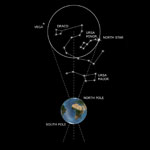The Earth, flattened at the poles, displays a bulge at the equator. The attraction exerted by the Sun and Moon on the bulge causes the axis of terrestrial rotation to describe a circle around the pole of the ecliptic in a 26,000-year period. This motion causes a shift in the equinoxes known as precession. Studied since antiquity, the phenomenon was first clearly identified by Edmond Halley (1656-1742).
Related objects








